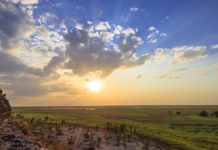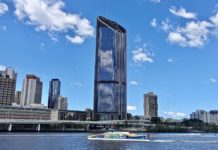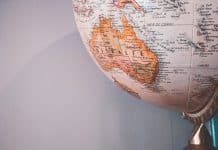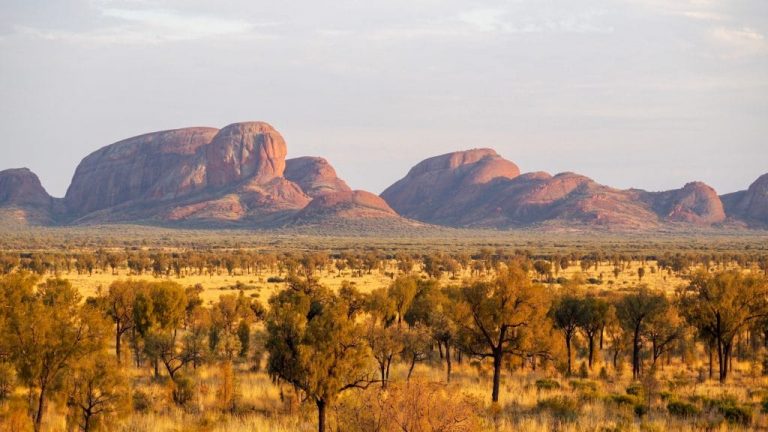
The Northern Territory (NT) covers more than 1,300,000 km². However, in spite of its size, it is also one of the least populated states. The Northern Territory of Australia is a land of awe-inspiring natural beauty, rich Aboriginal culture, and rugged outback adventures. From vibrant Darwin events to ancient Aboriginal rock art, here’s everything you need for an unforgettable Top End and Red Centre adventure.
Table of Contents
Explore Darwin & Surrounds
Darwin, although a small town, is a vibrant, multicultural hub. Capital of the Northern Territory, in addition to exploring the city, you can do several activities there.
Enjoy nature
Want to disconnect? Take a tour of the Botanical Garden and stroll among 42 hectares of vegetation. A favorite for the rainforest and the desert gardens. A good way to discover the flora of the region while taking a relaxing walk in the shade of the abundant vegetation.
Swimming in Darwin
The artificial lagoon allows you to swim in peace, while enjoying deckchairs and volleyball courts. Admission is free and the lagoon is patrolled by lifeguards from 9 a.m. to 6 p.m. every day. The lagoon is home to Cassiopeia fish, seaweed and jellyfish, all of which help maintain a healthy marine environment. The fish are known to occasionally visit swimmers.
You can also take a dip in the city’s Wage Lagoon wave pool. Open from 10 a.m. to 6 p.m. daily, the Wave Lagoon is one of Darwin’s most popular attractions. Admission is chargeable ($8 per person).
Head to Leanyer Recreation Park or Palmerston Water Park to splash around in the pool and slide down the water slides. All for free!
Explore the Markets
Visit Mindil Market (to the sound of eMDee’s didgeridoo) – every Thursdays and Sundays from April to October. Over 80 food stalls (laksa, barbecued barramundi), local crafts, live music and a breathtaking sunset over the Timor Sea. Do not miss Rapid Creek (Asian, Indian and Indonesian cuisine), Malak Market (organic produce), passing by Nightcliff, Parap and Palmerston.
Visit the Museum and Art Gallery of the Northern Territory (MAGNT)
Must-Sees: Indigenous art collection, Cyclone Tracy exhibit, and the World’s Largest Crocodile display.
Tip: Combine with a dip in the nearby Wave Lagoon to cool off after your visit
Go shopping
Smith Street (“The Mall”) is the main shopping street. It is full of souvenir shops! You will also find fashion boutiques, big Australian brands. In the middle of The Mall you will also find one of the oldest pubs in Darwin: the old Victoria Hotel.
Nightcliff Seabreeze Festival
- Dates: May 9–11, 2025 (dates for 2026 TBC)
- Why Go: Free admission, 180+ community events along the Nightcliff Foreshore, sand-sculpture contests, 3×3 basketball, and live sets from Yolngu band Wild Honey
Admire a sunset from the beach
Mindil, Vesteys and East Point are the best spots to enjoy the colors of dusk. They are also the meeting places for backpackers.

Litchfield National Park – Waterfalls & Magnetic Termite Mounds
Just a short drive from Darwin, Litchfield National Park is famous for its stunning waterfalls and crystal-clear swimming holes. It will take you on a day-long adventure. Its entrance is free and will allow you to enjoy many exceptional sites.
👍 What to do at Litchfield National Park?
- Admire the Termite Mounds: “Cathedral” and “Magnetic” mounds rising 1–2 m tall, aligned north–south by millions of termites.
- Enjoy swimming spots at Buley Rockhole, Florence Falls and Wangi Falls (Easy-access plunge pools under cascading falls—swim with rainbow lorikeets and flying foxes).
- Visit the former site of a tin mine. A good way to learn a little more about the extraction process.
- It is very pleasant to drive through the park: the red of the beaten earth contrasting with the bright green of the vegetation, all to the sound of cockatoos!

Kakadu National Park – World Heritage Wilderness
Kakadu National Park is Australia’s largest park, with 20,000km² of the surface to explore! Kakadu is a UNESCO World Heritage site known for its biodiversity and ancient Aboriginal rock art. The park’s landscapes vary from wetlands and rivers to sandstone escarpments. Begin your visit at the Bowali Visitor Center.
👍 Highlights
- Yellow Water Billabong Cruise: Dawn or dusk wildlife cruises (saltwater crocodiles, jabirus, buffalo).
- Ubirr & Nourlangie Rock Art: 20,000-year-old galleries showcasing Dreamtime stories.
- Jim Jim & Twin Falls: High-adrenaline 4WD tracks and plunge-pool swimming (seasonal access Nov–May).
- Gunlom Waterfall, where you will enjoy both a mythical view of the park as well as a swimming spot without any danger to cool off. A little further north, discover Barramundi Gorge and its clear waters.
🪃 Want to learn more about Aboriginal art? The artistic circuit from Burrungkuy to Nourlangie Rock will allow you to admire beautiful Aboriginal paintings. In Ubirr, enjoy the explanations of a guide (free) while discovering sublime Aboriginal paintings. At the top of a rock, you will enjoy an unobstructed view of the rest of the park, perfect to watch the sunset.
🕕 Park Pass & Practical Info
- Validity: 7 days; purchase online before arrival to skip queues.
- Dry Season (15 May–31 Oct): Adult 16+ AUD 40; Child (5–15) AUD 20; Family AUD 100.
- Tropical Summer (1 Nov–14 May): Adult AUD 25; Child AUD 12.50; Family AUD 65.
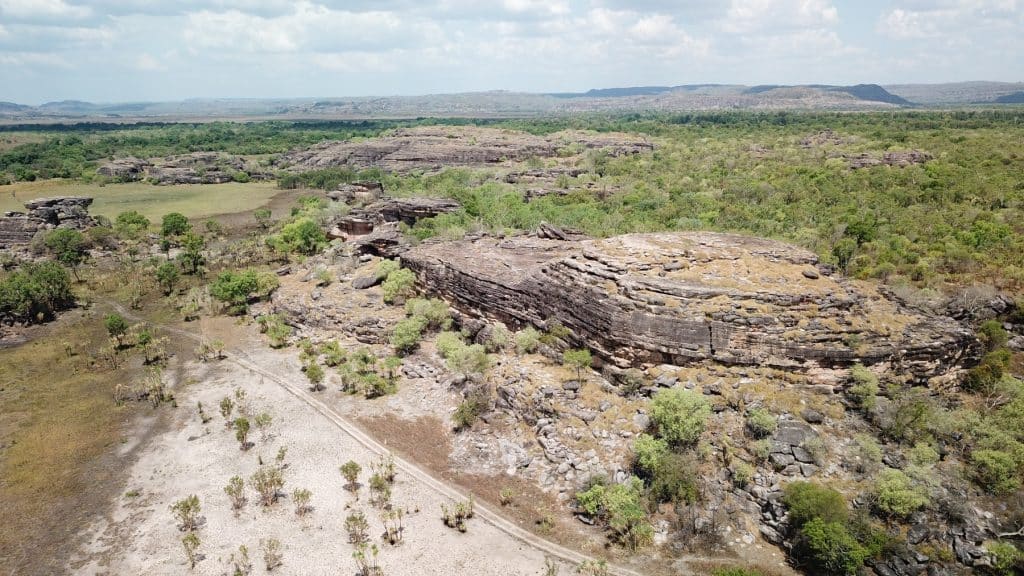
Katherine Hot Springs
Stop at Katherine to enjoy the hot springs. More extensive than those of Mataranka, this spring meanders through the rocks, providing for natural “seats”. Different access by stairs will allow you to jump into the water. Here again, you will have the choice: to swim among the hustle and bustle of the day, or to let yourself be tempted by the experience of swimming under the stars… You can also stroll along the river at Low-Level Reserve.
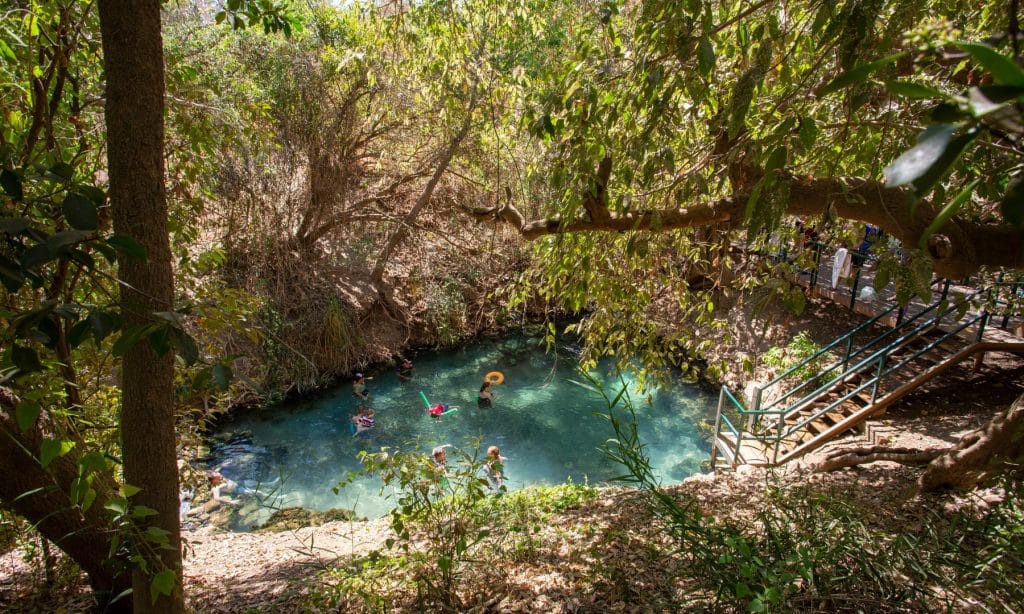
Nitmiluk (Katherine) Gorge – Stone Country & Waterways
Gorge Cruises & Canoeing
- Canoe Hire: Self-guided paddling (2–3 hours) into narrow gorges—perfect for active travellers
- Boat Tours: Two-hour cruises through towering sandstone walls, spotting freshwater crocs and native birds.
Hot Springs & Bushwalking
- Katherine Hot Springs: Thermal pools shaded by pandanus trees—ideal for a soothing dip.
- Jatbula Trail: 62 km trek through monsoon forest and sandy billabongs (requires permit, allow 5–6 days).
- Best swimming spots: Upper Pool, Lower Pool, Sweetwater Pool
- Sweetwater Pool & Edith Falls (8.9 km): Discover a succession of waterfalls and other natural pools in the shade of palm trees, in lush vegetation.
- Baruwei Lookout Loop (1.1 km): Many steps await you to discover a spectacular view of Katherine Gorge.
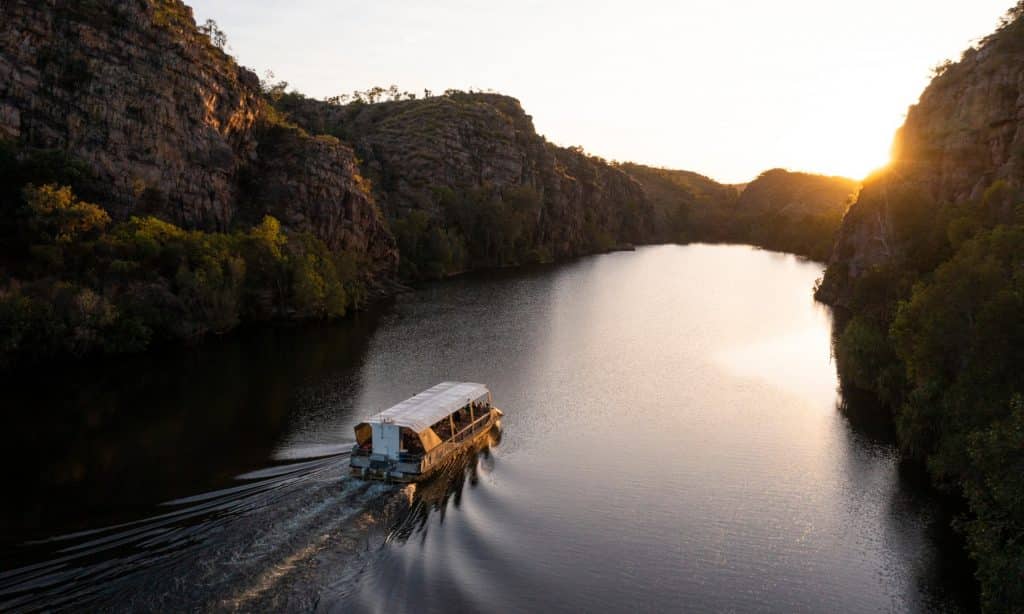
Mataranka, Bitter Springs
Arriving from the South, Mataranka certainly marks a notable change of scenery: the desert gives way to a green and wet mangrove. No doubt about it, you are in the tropics! To relax, you can enjoy two types of hot and natural springs.
👍 Highlights
- The Bitter Springs provides a small bathing circuit in a beautiful setting, closer to nature. A note of caution, this pleasant and frequented setting is also the habitat of crocodiles!
- You will also have free access to the Thermal Pool of the city camping which has a more family oriented atmosphere. If like me you want to avoid the crowds and dream of an unusual spot: try a midnight swim or take a dip at dawn!

🚐 Rent a Cheap Campervan
Our tips and discounts to rent a cheap campervan in Australia.
On Stuart Highway – While driving
During your journey on the endless Stuart Highway, between Darwin and Alice Springs, a few stops will be unmissable. Here are some ideas for unusual spots to stop for well-deserved breaks on the road.
Wycliffe Well
Take a picture with aliens in this funny gas station. Be careful, they are even present inside the shop!
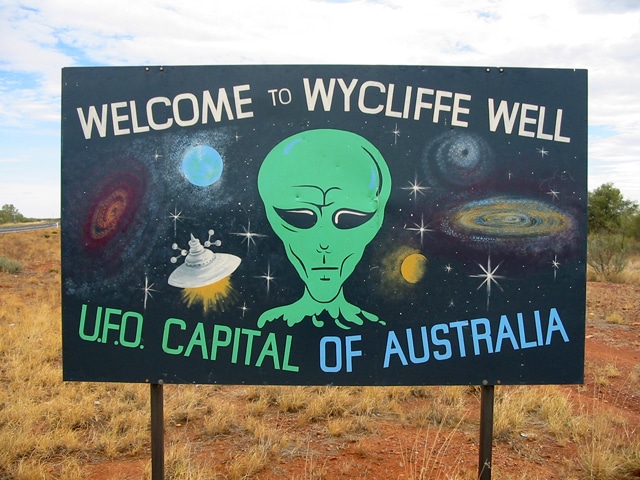
Newcastle Waters
For something a little different, visit the abandoned houses and restaurants of this ghost town. Newcastle Waters was once a large and historic cattle station. The main attraction is Drovers Memorial Park which has an impressive herdsman statue. The city is located 790 km north of Alice Springs and 716 km south of Darwin.
Daly Waters
This little pub lost in the middle of nowhere and one of the best known in Australia. The tradition of the bar is that each visitor leaves a souvenir after his visit. Complete the collection as you wish: expired identity card, old plane tickets, postcard or underwear. Everything is allowed !
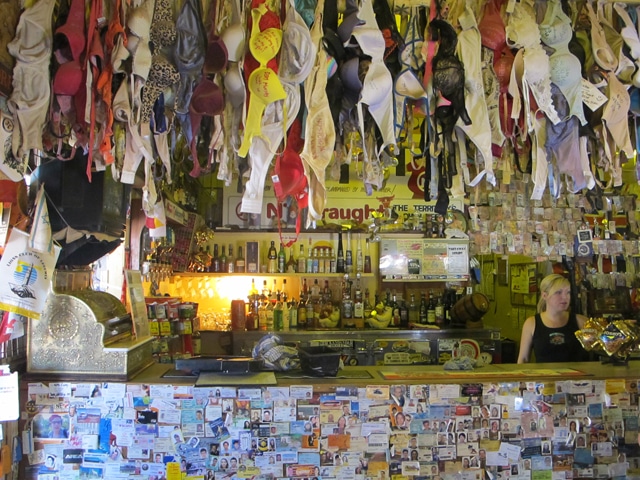
Devils Marbles (Karlu Karlu)
A multi-million-year-old geological show, Karlu Karlu is quite interesting to visit on the way.
The marble of the devil is actually granite, which sparkles in the sun. The Warumungu, Kaytetye, Alyawarra and Warlpiri Aborigines who have been watching over the place since the dawn of time have simply called it a “rounded rock block”. A very befitting name.
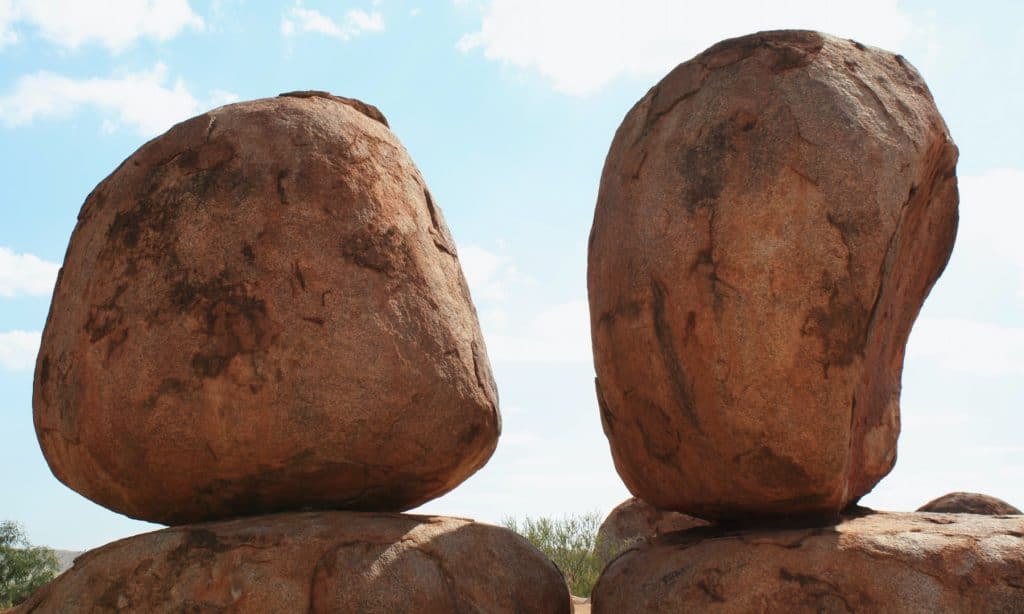
Alice Springs
In the middle of the desert, Alice Springs is the only big city in the outback (33,000 inhabitants). This is why a stop is essential before venturing further! Stroll through the shopping street of Todd Street and enter its many Aboriginal art galleries (Muk Muk Indigenous Fine Art, Mbantua, Papunya Tula…).
👍 Highlights
- Climb to the top of the Anzac Hill Memorial and enjoy a 360° view of the city and its surroundings.
- Olive Pink Botanic Garden to discover the desert flora and fauna.
- Alice Springs Desert Park: Immersive nocturnal tours and endangered species presentations.
- Araluen Arts Centre: Contemporary Indigenous art exhibitions and performances
Tip: Take advantage of the conveniences of the city before taking the road to the Outback (supermarkets, showers, WCs, laundries!)
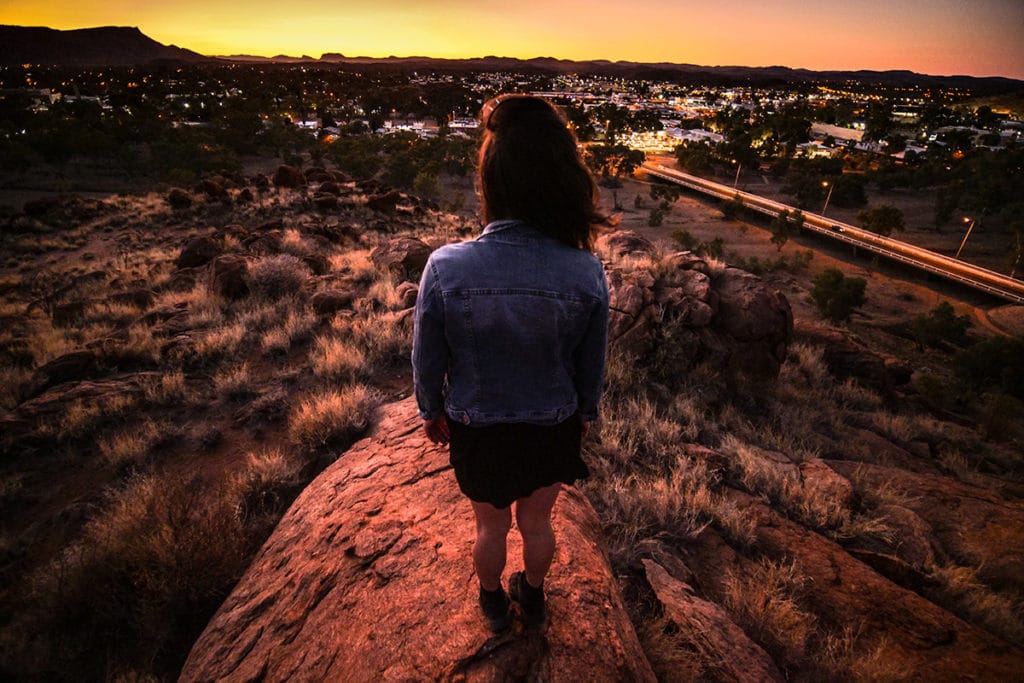
East MacDonnells Ranges
At East MacDonnells Ranges you will find unspoiled natural areas, such as Emily (Anthwerrke) and Jessie Gap (Yeperenye). It is a little less crowded than the west side. If you are really quite and go in the early morning or at dusk you will be able to see amazing wildlife!
Practical Info
The main road to access the various points of interest is paved (Corroboree Rock Conservation Reserve for example). But a few kilometers will lead you over gravel roads, including Trephina Gorge Nature Park and Ellery Creek Big Hole. A day is enough to visit these sites because the steps are never very long. Plan an extra half day if you want to join Ruby Gap Park, which has a long stretch of off-road.
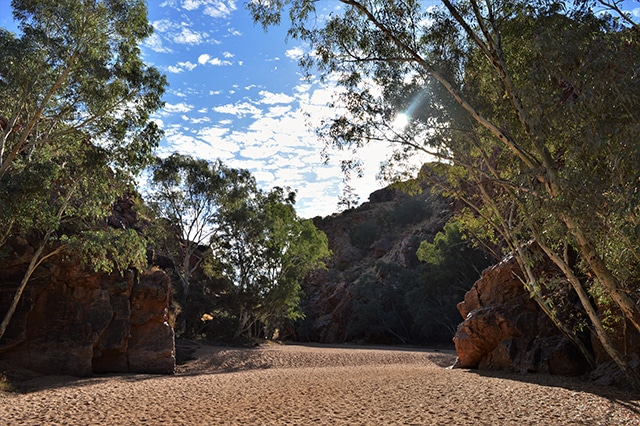
💰 10% discount on your insurance policy
Find here all the information you need and get your 10% Go walkabout promo code for any policy.
West MacDonnells Ranges (Tjoritja)
The MacDonnells mountain range stretches west for more than 161km.
Iconic Gaps & Waterholes
- Simpsons Gap: Striking red cliffs framing a permanent waterhole—spot black-footed rock wallabies at dawn.
- Standley Chasm (Angkerle): Fiery sunlight highlights the narrow gorge walls around midday. The only access to Standley Chasm (Angkerle Atwatye) costs $ 12.
- Ocher Pits: The extracted ocher is still used today for the ceremonies of Western Arrernte, Aboriginal community to which the mine belongs.
- Ellery Creek Big Hole: One of the region’s largest, most picturesque swimming spots.
Uluru & Kata Tjuta National Park – Red Centre Classics
This UNESCO World Heritage Site promises a magical, spiritual, and highly interesting discovery. The park is located approximately 500 km from Alice Springs. Start your trip with a visit to the cultural center. It will provide you with information about the Aboriginal culture, the symbol of Uluru and how this park is now managed.
Uluru is the largest sandstone monolith in the world (348 meters high and 9.4 km wide). It is 30 km from Kata Tjuta, consisting of 36 sandstone domes spanning 20 km. To enjoy these unique places, we advise you to take a few hiking trails.
(If you plan to extend beyond the Top End, don’t miss our dedicated Uluru-Kata Tjuta itinerary.)
🥾 What hikes to do in Uluru-Kata Tjuta?
- Minymaku Wald and Watiku Platform Trail (1.4 km): Accessible to young and old, this walk allows you to admire Uluru from afar, to enjoy its surroundings.
- Mala Walk (2 km): This walk is offered daily and free of charge by a park ranger. It takes you to the foot of the rock and tells you the story of Uluru and its people.
- Walpa Gorge Walk (2.6 km): Very accessible, this walk immerses you in the bowels of the domes. Immersion guaranteed!
- Valley of the Winds (7 km): This loop starts in Kata-Tjuta and takes you to breathtaking views in the Valley of the Winds.
- Uluru Base Walk (10.9 km): If you prefer to be at the base of Uluru, this is the walk you should choose.
Not to be missed: The sunrises and sunsets on both Uluru and Kata-Tjuta are stunning and worth the detour on their own.
🕕 Practical Info
Park entry: $38 for 3 days.
Park hours: 5 a.m. to 9 p.m. in summer, 6:30 a.m. to 7:30 p.m. in winter.
Cultural center hours: 7 a.m. to 6 p.m.
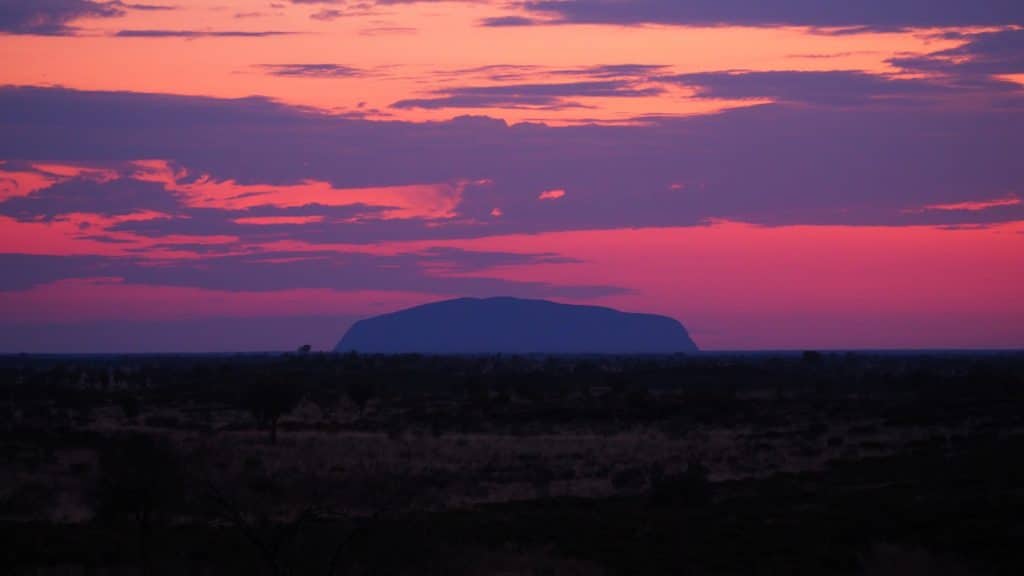
King’s Canyon (Watarrka National Park)
Watarrka National Park is accessible via an asphalt road. However, if you have an appropriate vehicle, you can take one of the “shortcuts” via the Mereenie Loop or another track.
🥾 What hikes to do in King’s Canyon?
- South Wall Return (5 km): This trail joins the heights of King’s Canyon and offers you a shorter version of the Rim Walk.
- Kings Creek Walk (almost 3km): Easy, this trail runs along the river, passes at the foot of the limestone cliffs and leads you to the center of the canyon.
- Rim Walk is a 6km loop. If we had to recommend just one hike, it would be this one. The trail is more difficult than the others as some steep climbs are to be expected. But the fact of gaining height is well worth the detour. In a lunar setting, walk along the steep cliffs sculpted by erosion and enjoy a bird’s eye view of the canyon and the Garden of Eden.
- Kathleen Springs Walk (3 km): Shaded, this trail takes you to a pool to cool off and picnic near the water.
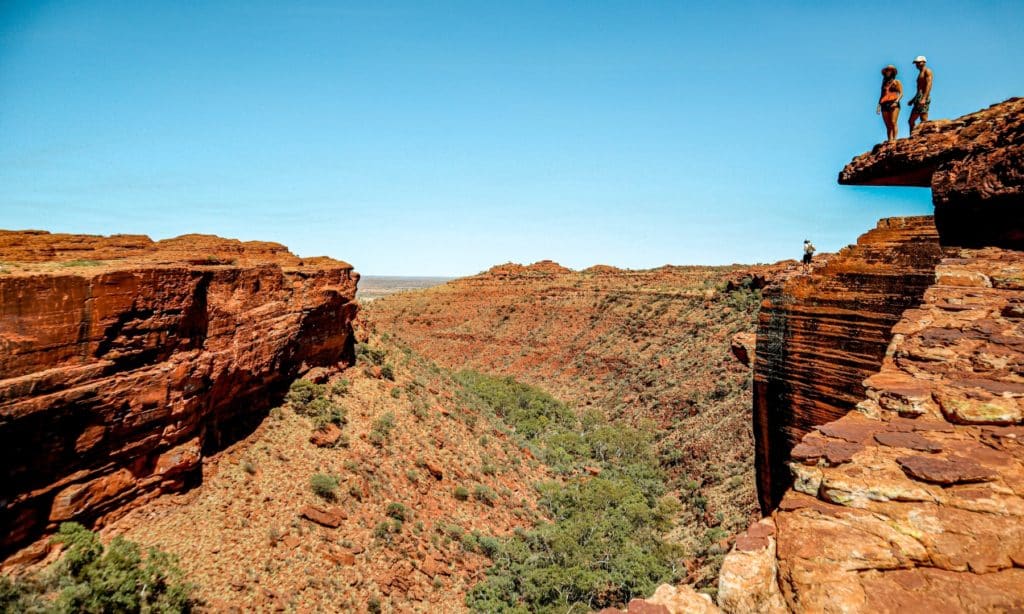
Best time to visit Northern Territory
The best time to visit the Northern Territory is during the dry season, from May to October. During this period, the weather is cooler, and most roads and attractions are accessible. The wet season, from November to April, can be hot and humid with heavy rains and possible flooding. If you visit during this period, always make sure to check the road conditions before heading to a National Park.
Dry Season (May–Oct): Sunshine, low humidity, all roads open.
Wet Season (Nov–Apr): Lush landscapes, fewer crowds—but some parks flood.
Practical Travel Tips
Permits & Passes
- NT Parks Pass (NT Govt): 12-month open pass AUD 60 Adult, AUD 30 Child (covers most NT parks except Kakadu/Uluru).
- Kakadu Pass (Parks Australia): See above.
Getting Around
- Self-Drive: 4WD strongly recommended for remote tracks (Jim Jim, Gunlom).
- Guided Tours: Ideal for top sites—learn from Indigenous guides and rangers.
Safety & Respect
- Wildlife: Maintain safe distances (crocodiles, buffalo).
- Cultural Sites: Obey signage; do not climb sacred formations.
- Sun Protection: Hat, sunscreen, and 3 L water per person per day.
Budget Considerations
- Accommodation: Varies from luxury resorts to budget hostels and camping. Advance booking is recommended.
- Food: Options range from fine dining in cities to more affordable local eateries. You will always find supermarkets to refill.
- Transport: Renting a car or a campervan is advisable for flexibility, but remember that distances are vast.
- Tours: Guided tours can be pricey but offer unique insights and access to remote areas.
The Northern Territory of Australia is a land of contrasts and ancient cultures, offering a diverse range of experiences for every type of traveler. Whether you’re seeking adventure, cultural insights, or just a chance to connect with nature, NT has something special to offer. Plan your trip according to your interests, budget, and the season to make the most of this extraordinary destination.




















